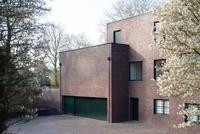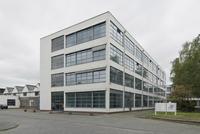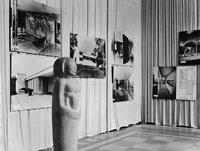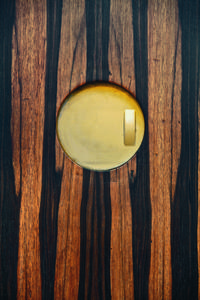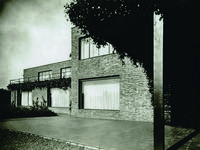More Mies. 10th Krefelder ArchitekturtageModernism for All. Mies Van Der Rohe and Egon Eiermann–Haus Esters, Haus Lange
Ludwig Mies van der Rohe (1886 Aachen - Chicago 1969) is one of the 20th century's outstanding architects and designers, whose creations changed the whole architectural language in Germany, even in the USA. His idea of functionality, formal lucidity, materiality and technical innovation are present in his constructions, also in Krefeld. For the textile Manufacturers Hermann Lange and Josef Esters he designed the houses Lange and Esters (1927/30) and for Verseidag the dye works building (1930/31).
Egon Eiermann (1904-1970), who built the Kaiser Wilhelm Gedächtniskirche in Berlin, is regarded as one of the most influential post-war modernist architects in West Germany. Mies van der Rohe was an important model for him, whom he greatly admired. The paths of the two architects cross in Krefeld. At the beginning of the 1950s, Eiermann built the adminstrative building for Verseidag, which now serves as the city hall, and for which Mies van der Rohe also submitted a design shortly before the outbreak of the second World War. Josef Esters for his part commissioned Eiermann to design a house for the garden of the villa that Mies had built, but sadly it was never carried out.
The 10th krefelder architekturtage will examine the connections between Mies and Eiermann by looking at the example of the Krefeld buildings, and cast an eye on the continuation of “new architecture” in the post-war period.
The programme will be conducted in German language.
You can book guided tours in englisch language: kunstmuseen@krefeld.de

Exhibitions currently on view
Related past exhibitions

Photo: Dirk Rose Past exhibitionMORE MIES. Two weeks of pure architecture–Haus Esters, Haus Lange
Ludwig Mies van der Rohe
Herrenfutterstoffe-Gebäude, 1930/31, Krefeld
Foto: Volker DöhnePast exhibitionMore Mies. 14th Krefelder ArchitekturtageModern Times—Mies and Factory Building–Kaiser Wilhelm Museum Past exhibitionMore Mies. 13th Krefelder ArchitekturtageMies van der Rohe and Space–Haus Esters, Haus Lange
Past exhibitionMore Mies. 13th Krefelder ArchitekturtageMies van der Rohe and Space–Haus Esters, Haus Lange Past exhibitionMore Mies. 12th Krefelder ArchitekturtageModern Living. Modernist Furniture Design and Interior Design–Haus Esters, Haus Lange
Past exhibitionMore Mies. 12th Krefelder ArchitekturtageModern Living. Modernist Furniture Design and Interior Design–Haus Esters, Haus Lange Past exhibitionMore Mies. 11th Krefelder ArchitekturtageMies All in Green–Haus Esters, Haus Lange
Past exhibitionMore Mies. 11th Krefelder ArchitekturtageMies All in Green–Haus Esters, Haus Lange Past exhibitionMore Mies. 9th Krefelder ArchitekturtageMies Van Der Rohe and the Photography–Haus Esters, Haus Lange
Past exhibitionMore Mies. 9th Krefelder ArchitekturtageMies Van Der Rohe and the Photography–Haus Esters, Haus Lange- Past exhibitionMore Mies. 8th Krefelder ArchitekturtageMies Van Der Rohe and the Bauhaus–Haus Esters, Haus Lange
- Past exhibitionMore Mies. 7th Krefelder ArchitekturtageMies Van Der Rohe and Art–Haus Esters, Haus Lange
- Past exhibitionMore Mies. 6th Krefelder ArchitekturtageModel – Reconstruction – Interpretation–Haus Esters, Haus Lange
- Past exhibitionMore Mies. 5th Krefelder ArchitekturtageMore Mies: 1928–Haus Esters, Haus Lange
- Past exhibitionMore Mies. 4th Krefelder ArchitekturtageMore Mies: Early Ties–Haus Esters, Haus Lange
- Past exhibitionMore Mies. 3rd Krefelder Architekturtage–Haus Esters, Haus Lange
- Past exhibitionMore Mies. 2nd Krefelder Architekturtage–Haus Esters, Haus Lange
- Past exhibitionMore Mies. 2st Krefelder Architekturtage–Haus Esters, Haus Lange
